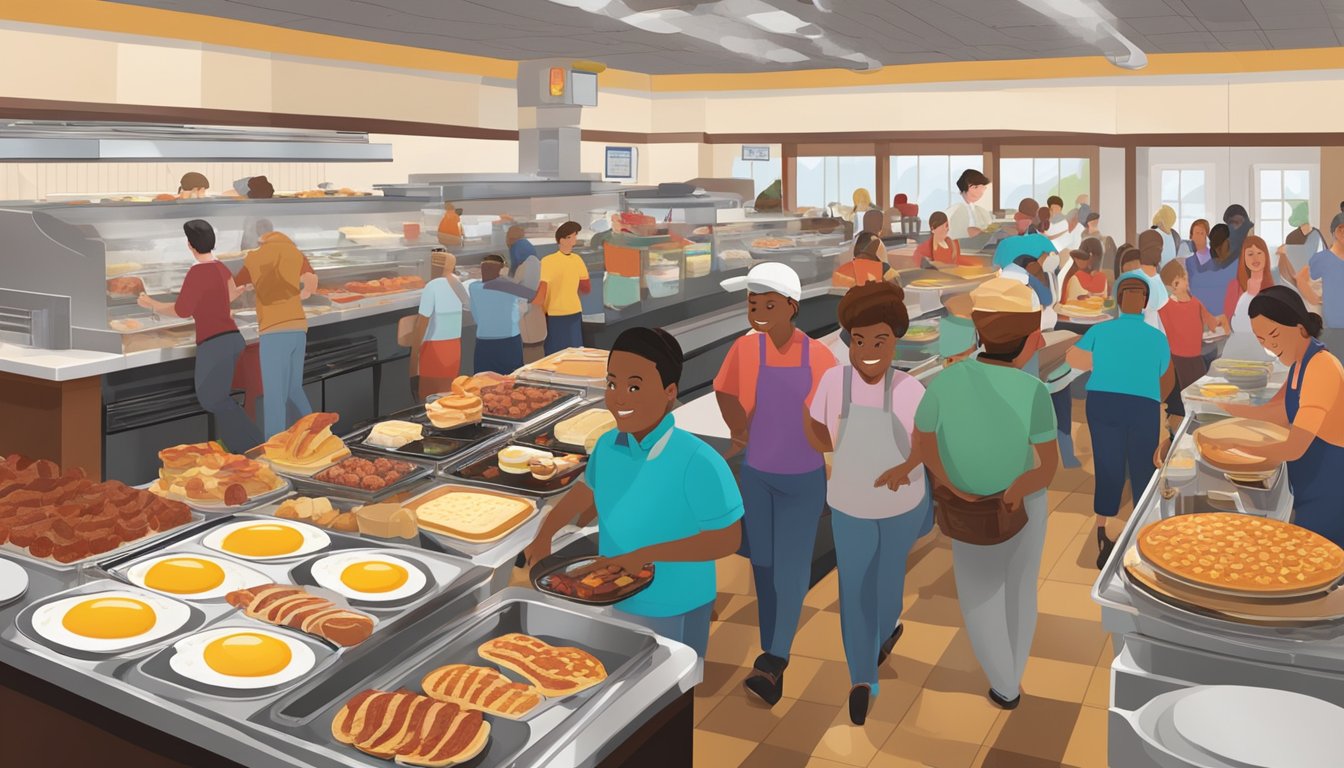Golden Corral’s all-you-can-eat breakfast buffet offers a unique economic proposition for both diners and the restaurant chain. Priced at around $12.99 per person, this buffet provides substantial value compared to typical mid-range American breakfast options costing $15-$25.
The buffet model allows Golden Corral to serve a large number of customers efficiently while keeping operational costs low. Self-service eliminates the need for wait staff, and batch cooking of less complex dishes enables a smaller kitchen crew to handle high volumes. This streamlined approach contributes to the chain’s ability to offer competitive pricing.
For customers, the all-you-can-eat format presents an opportunity to maximize their dining experience within a fixed price point. The wide variety of breakfast items available caters to diverse preferences, potentially attracting larger groups and families looking for an affordable meal option that satisfies everyone’s tastes.
Concept of All-You-Can-Eat Buffets
All-you-can-eat buffets offer unlimited food for a fixed price. This model appeals to customers seeking variety and value, while restaurants balance profitability through careful planning and consumer psychology.
Historical Perspective
The concept of all-you-can-eat buffets has roots in 16th century Sweden’s smörgåsbord. It gained popularity in the United States during the 1940s and 1950s. Las Vegas casinos popularized lavish buffets to attract gamblers.
Early buffets focused on quantity over quality. Over time, they evolved to offer more diverse and higher-quality options. The 1980s and 1990s saw a boom in buffet-style restaurants across America.
Today, buffets range from budget-friendly chains to upscale hotel offerings. They’ve adapted to changing tastes and dietary requirements, including healthier options and international cuisines.
Psychological Appeal
All-you-can-eat buffets tap into several psychological factors that drive consumer behavior. The perception of value is a key draw – customers feel they’re getting more for their money.
Choice is another powerful motivator. Buffets offer a wide array of options, satisfying diverse tastes and preferences. This variety can be especially appealing to groups with different dietary needs.
The freedom to try new foods without committing to a full dish is attractive to many. It allows for experimentation and discovery of new flavors.
Buffets also cater to the desire for immediate gratification. There’s no waiting for food to be prepared – it’s all readily available.
How it Works
All-you-can-eat buffets operate on a fixed-price model. Customers pay a set amount regardless of how much they consume. This creates a perception of unlimited choice and value.
Restaurants carefully plan their offerings to balance cost and appeal. They use smaller plates to control portion sizes and arrange food strategically to guide choices.
Less expensive items like rice or pasta are often placed at the beginning of the line. Pricier proteins are typically served in smaller portions or require staff assistance.
Food cost management is crucial. Buffets rely on some customers eating less to offset those who eat more. They also minimize waste through careful forecasting and preparation techniques.
Pricing strategies vary. Some buffets charge different rates for lunch and dinner or on weekends. Others offer discounts for children or seniors to attract a wider customer base.
Golden Corral’s Business Model
Golden Corral operates on an all-you-can-eat buffet model that balances customer value with cost-effective operations. The restaurant chain focuses on high-volume traffic and diverse food offerings to drive profitability.
Revenue Streams
Golden Corral’s primary revenue source is its buffet-style dining experience. Customers pay a fixed price for unlimited access to a wide variety of food options. This model encourages higher customer volume and repeat visits.
The restaurant offers breakfast, lunch, and dinner buffets, each with different pricing. Special promotions and discounts for certain groups, like seniors or military personnel, help attract diverse customer segments.
Golden Corral also generates income through beverage sales, which often have higher profit margins than food items. Some locations offer catering services or private event hosting as additional revenue streams.
Cost Management
Efficient cost control is crucial for Golden Corral’s profitability. The chain leverages economies of scale by purchasing ingredients in bulk, reducing per-unit costs. This allows them to offer a wide variety of foods at competitive prices.
Labor costs are minimized through the self-service buffet format, requiring fewer wait staff than traditional restaurants. The kitchen operates with a streamlined crew, focusing on batch preparation of simpler dishes.
Food waste management is a key focus. Golden Corral uses data analytics to predict customer traffic and food consumption patterns, helping optimize food preparation and reduce waste. Portion control measures, such as using smaller plates, subtly encourage customers to take only what they’ll eat.
Energy-efficient equipment and practices help reduce utility costs across locations. The chain also implements standardized processes and training programs to maintain consistency and efficiency in operations.
Economies of Scale in Buffet Operations
Buffet chains like Golden Corral leverage economies of scale to reduce costs and maximize efficiency. This allows them to offer all-you-can-eat breakfast options at competitive prices while maintaining profitability.
Purchasing Power
Large buffet chains benefit from bulk purchasing agreements with suppliers. Golden Corral can negotiate lower prices for ingredients by ordering in massive quantities. This reduces the cost per unit for items like eggs, bacon, and pancake batter.
Centralized purchasing departments further streamline the process. They coordinate orders across multiple locations, ensuring consistent quality and pricing. Seasonal contracts with farmers and producers lock in favorable rates for fresh produce and meats.
Long-term relationships with suppliers often lead to preferential pricing and priority access to high-quality ingredients. This purchasing power enables Golden Corral to offer a wide variety of breakfast items at a lower cost than smaller restaurants.
Operational Efficiency
Buffet chains optimize their kitchen operations to handle high-volume food production. Standardized recipes and cooking procedures ensure consistency across locations. Industrial-grade equipment, like large griddles and conveyor toasters, increases output while reducing labor needs.
Self-service buffet style minimizes the need for wait staff. Customers serve themselves, allowing Golden Corral to operate with fewer employees per guest. This labor efficiency significantly reduces operational costs.
Centralized menu planning and inventory management systems help reduce food waste. Predictive analytics based on historical data guide ordering and preparation quantities. Batch cooking techniques allow kitchens to replenish food items quickly during peak hours without overproducing.
Cross-training employees to handle multiple roles increases flexibility and productivity. This approach allows Golden Corral to adjust staffing levels based on customer traffic, further optimizing labor costs.
Pricing Strategies for Buffets
Buffet pricing involves carefully balancing costs and perceived value to attract customers while maintaining profitability. Effective strategies consider food costs, customer demographics, and competitive positioning.
Setting a Reasonable Price
Golden Corral typically sets breakfast buffet prices between $8.99 and $11.99, depending on location and day of the week. This range aims to cover food costs while remaining affordable for families. Weekday prices are often lower to drive traffic during slower periods. Weekend prices may increase slightly to account for higher demand and premium items like made-to-order omelets.
Pricing also factors in local competition and income levels. Urban locations with higher operating costs may charge more than rural restaurants. Senior and children’s discounts help attract key demographics.
Balancing Cost and Value
Food costs for buffets generally run 30-35% of the meal price. Golden Corral manages this by offering a mix of low-cost staples like eggs and pancakes alongside higher-value items such as bacon and fresh fruit. This variety creates perceived value for customers.
Portion control plays a key role in profitability. Smaller plates encourage multiple trips but reduce waste. Strategically placing costlier proteins at the end of the buffet line can decrease consumption.
Labor costs are minimized through self-service, though staff are needed to restock and maintain food quality. High-volume locations benefit from economies of scale in food purchasing and preparation.
Consumer Behavior and Buffets
All-you-can-eat breakfast buffets at Golden Corral attract customers with unlimited choices and the opportunity to maximize value. Consumer behavior at these buffets is influenced by psychological factors and individual eating habits.
The Allure of Unlimited Choices
Golden Corral’s breakfast buffet offers a wide array of options, from classic breakfast staples to unique dishes. This variety appeals to diners seeking choice and customization. Many customers enjoy the freedom to sample multiple items without committing to a single dish.
The buffet format encourages exploration and experimentation. Diners can try new foods with minimal risk, as they can always return for familiar favorites. This abundance of choice can lead to increased satisfaction and perceived value.
However, too many options can sometimes lead to decision fatigue. Some customers may feel overwhelmed by the selection, potentially impacting their overall experience.
Average vs. High Volume Eaters
Buffet economics rely on a balance between average and high-volume eaters. Most customers consume a moderate amount, aligning with the restaurant’s cost projections. These average eaters form the backbone of the buffet’s profitability.
High-volume eaters, while less common, can significantly impact the buffet’s bottom line. These customers aim to maximize their value by consuming larger quantities. Golden Corral accounts for this behavior in their pricing strategy.
The restaurant employs various tactics to manage food costs:
- Strategic food placement
- Portion control for certain items
- Encouraging side dishes and lower-cost fillers
By understanding and accommodating different eating patterns, Golden Corral maintains profitability while satisfying diverse customer preferences.
Menu Design and Food Offerings

Golden Corral’s breakfast buffet features an extensive array of dishes designed to appeal to diverse tastes and dietary needs. The menu combines traditional favorites with unique offerings to create a memorable dining experience.
Diversity of Dishes
The breakfast buffet at Golden Corral boasts a wide variety of options. Guests can choose from classic morning staples like scrambled eggs, bacon, sausage, and pancakes. Hot cereals, fresh fruit, and yogurt provide lighter alternatives.
Made-to-order omelets allow for customization. Waffles and French toast satisfy those with a sweet tooth. Southern-inspired items like biscuits and gravy appeal to regional tastes.
The buffet also includes lunch-style offerings for late risers, such as fried chicken and pot roast. This diversity ensures there’s something for everyone, regardless of preferences or time of arrival.
Desserts and Specialty Items
Golden Corral’s breakfast buffet goes beyond standard morning fare with its dessert and specialty selections. A highlight is the cotton candy machine, adding a whimsical touch to the experience.
Fresh-baked pastries, muffins, and danishes tempt guests. The buffet features a rotating selection of cakes, pies, and cookies. Ice cream with various toppings is available for those craving a cold treat.
Specialty items like breakfast pizzas and breakfast burritos offer unique twists on morning classics. These items help set Golden Corral apart from other buffet chains and keep the menu exciting for repeat customers.
Adapting to Dietary Restrictions
Golden Corral has adapted its breakfast buffet to accommodate various dietary needs. Low-carb dieters can find protein-rich options like eggs, meats, and cheese.
Vegetarian choices include fresh fruits, vegetables, and meat-free breakfast items. Gluten-free diners have options such as oatmeal and certain egg dishes.
Clear labeling helps guests identify allergens and nutritional information. Staff members are trained to assist with dietary questions. While not exhaustive, these adaptations demonstrate Golden Corral’s effort to cater to a broader range of dietary requirements.
Marketing All-You-Can-Eat Breakfast Buffets
Effective marketing strategies are crucial for attracting customers to all-you-can-eat breakfast buffets. Promotional tactics and targeting specific demographics play key roles in driving traffic and revenue for buffet restaurants.
Promotional Strategies
Buffet restaurants often employ visually appealing advertisements to showcase their breakfast offerings. High-quality images of pancakes, eggs, bacon, and fresh fruit can entice potential diners. Many establishments use social media platforms to share mouth-watering photos and limited-time offers.
Email marketing campaigns target loyal customers with special discounts and early bird specials. Some buffet chains partner with local hotels to offer package deals for tourists. Digital coupons and promotional codes distributed through mobile apps can drive foot traffic during slower periods.
Television commercials highlighting the variety and value of breakfast buffets are common for larger chains. Billboards and radio ads in high-traffic areas remind commuters about convenient breakfast options.
Target Demographics
All-you-can-eat breakfast buffets appeal to a wide range of demographics. Families with children appreciate the diverse menu options and cost-effective pricing. Parents can find something for even the pickiest eaters without breaking the bank.
Senior citizens often enjoy the relaxed atmosphere and ability to sample multiple dishes. Many buffet restaurants offer senior discounts to attract this demographic. College students and young adults are drawn to the value proposition of unlimited food for a fixed price.
Business professionals may frequent breakfast buffets for quick, satisfying meals before work. Some establishments create loyalty programs tailored to regular customers in this demographic. Weekend brunch crowds, including friend groups and couples, are another key target market for all-you-can-eat breakfast offerings.
Economic Analysis of Buffets

All-you-can-eat buffets operate on a unique economic model. Customers pay a fixed price for unlimited food, creating an interesting dynamic between consumer behavior and restaurant profitability.
The marginal cost for buffets decreases with each additional serving. Once food is prepared, the cost of serving one more plate is minimal. This allows restaurants to offer seemingly unlimited quantities while controlling expenses.
Buffets rely on average consumption patterns to remain profitable. While some diners may eat more than the ticket price value, others eat less, balancing out overall food costs.
Pricing strategy is crucial for buffet economics. Restaurants must set prices high enough to cover costs and generate profit, but low enough to attract customers. The perceived value of unlimited food often outweighs the actual amount consumed.
Consumer psychology plays a significant role in buffet economics. The prospect of unlimited food can lead to overconsumption, but physical limitations and diminishing returns on satisfaction typically prevent excessive eating.
Buffets often use lower-cost ingredients and efficient preparation methods to maintain profitability. This allows them to offer a wide variety of options while keeping food costs manageable.
The economic success of buffets hinges on balancing customer satisfaction with operational efficiency. By understanding consumer behavior and carefully managing costs, buffet restaurants can create a profitable business model based on the allure of all-you-can-eat dining.




